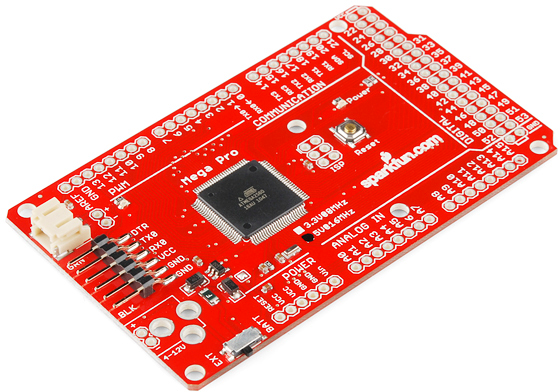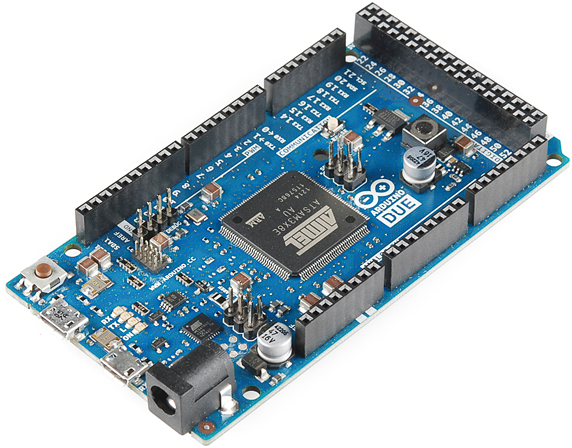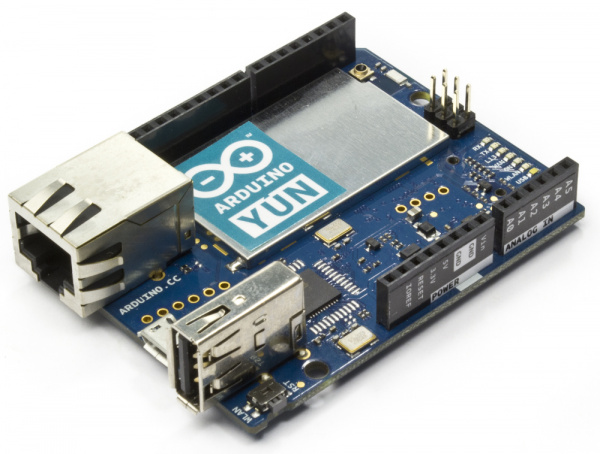Arduino Comparison Guide
This Tutorial is Retired!
We have updated this tutorial in "Choosing an Arduino for Your Project." If you are looking to compare specs of different Arduino boards you can view our Arduino Comparison Guide.
View the updated tutorial: Choosing an Arduino for Your Project
Megas, ARMs, Yúns...Oh My!
Need some extra "beef" in your Arduino? Need more I/O pins, or a faster processor? That's where Arduino's like the Mega or the Due come into the picture.
Arduino Mega: The Souped Up Uno
The Arduino Mega is what you might get if you packed four Arduino Uno's into one board. There are 54 I/O pins, instead of the 14 an Uno gives you. That's a whole lot of extra LEDs! Instead of one hardware serial port, there are four. And the Mega sports a whopping 256 kB of flash program space. Not to mention 16 analog inputs, and 14 PWM outputs. The Mega just has more of everything.
The brain of the Mega is an ATmega2560, a fully souped up ATmega328. Aside from the massive processor overhaul, the Mega still shares a lot in common with the Arduino Uno. There's a secondary IC on-board (an ATmega16U2) to convert USB-to-serial to allow USB programming. It runs at the same speed -- 16 MHz. All of the pins are broken out in a way that keeps the board shield-compatible. Because of these similarities, the Mega is a good option for Arduino beginners and experts alike.
If your Arduino project is hitting a wall because you don't have enough I/O, or if you're running out of program space, consider stepping up to the Mega.
Mega Pros
This seems to be a trend, doesn't it? If you're looking for a stripped-down version of the Mega -- no USB-to-serial converter, no connectors -- there's the Mega Pro 5V and 3.3V/8MHz variants.
With all of those I/O's it's hard to make a "mini" version, but the Mega Pro Mini 3.3V gets close. This board breaks out each of the pins to sets of small 8-pin connectors. A special cable is required to interface with them.
Like other Pro Arduinos before them, the Mega Pros all require an FTDI Basic for programming.
Arduino Due: Arduino Harder
You thought the Mega was powerful? The Arduino Due is a revolutionary take on the Arduino platform. It sports an entirely different processor architecture -- ARM instead of AVR. It's a 32-bit processor, clocks in at 84 MHz, and has native USB support.
This thing sports many unique features that other boards don't have. Stuff like:
- Two digital-to-analog converters (DACs), which allow the board to output true analog values (instead of PWM). This means you can play audio out it!
- USB on-the-go (OTG) capability allows the Due to act as both a USB device and a host. So you can hook up other USB devices -- like flash drives, WiFi modules, or phones -- to the Due.
- Direct Memory Access (DMA) allows the microcontroller to offload memory-access tasks, so it can perform other operations at the same time.
There are also some new things to watch out for. The Due's processor -- an ATSAM3X8E -- can't work at 5V, so the board only runs at 3.3V This means it may not be compatible with all shields.
The Due has some amazing functionality, but it's also a more advanced board. It's not recommended for beginners, but if you have a project that might take advantage of the Due's unique characteristics, check it out!
Arduino Yún
The Arduino Yún has true microprocessor power. It actually runs Linux! It works over WiFi! It's awesome.
The Yún combines an ATmega32U4 (the same MCU on Leonardos) and an embedded Linux machine running the OpenWRT Linux OS. The two processors are "bridged" together. You program the ATmega32U4, just like you program an Arduino Leonardo, over USB. The 32U4 can send commands to the Linux processor, just as you might send commands to your Linux computer in a terminal.
This board is packed full of all sorts of neat features. It can be programmed over-the-air, as long as your computer is on the same WiFi network. It's designed to easily interact with the Internet, so if your intend on making an "Internet-of-Things"-type project, the Yún may be the perfect Arduino.




